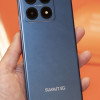Review: Samsung SYNC
At first glance the Sync looks large. Especially when compared to the majority of Cingular's 2G lineup, and even when compared to svelte high-end EV-DO handset like the VX8600 or Drift. However a closer comparison reveals the Sync takes up about the same amount of volume as these other phones, only it is smooshed into a flatter, wider shape. Although the shape doesn't evoke the thinness of the RAZR, it follows the same design strategy.
The thinner shape means the Sync sits nicely in your pocket - it does not produce a bulge or poke against you like smaller but thicker handsets do. Samsung also makes use of the extra width created by the slim profile, packing the inside of the clamshell with a large QVGA screen as well as a very large keypad.
The Sync feels nice in your hand when closed. The outside edges are all gently rounded, making it easy to grip despite its width. It is an easy shape to wrap your hands around and the whole unit feels solid as you grip it. Part of this is also due to the weight of the Sync. While the majority of the handset is plastic, it does not feel light or cheap.
There is a solid thunk as you open the Sync. Its hinge is wide, eliminating any wobble one might feel opening some phones. After a week of heavy use, the plastics still feel tight and there are no creaks in the hinge or anywhere else. Every aspect of the body feels solidly constructed.
While the phone is easy to grip closed, it is not so easy to grip open. It is a little wide to hold comfortably in use. This problem is exacerbated by the fact that Samsung placed the antenna along the bottom edge of the Sync, so you cannot wrap your hand around the bottom half without degrading reception. Instead you must find a way to wrap your hand around the middle of the open clamshell. This eventually proved too awkward, forcing us into using a Bluetooth headset full time with this phone.
Keypad
Each key is large and slightly raised from the surface of the keypad. Although the keys are barely raised enough to see the difference, there is a large enough space between each one to feel the change. The D-pad is surround by a ring that is equally subtle, however the center select key is raised enough that it is easy to hone in on by feel alone. Each press on the keypad has a nice click to it, giving the impression that the keys are traveling much further than they really are when you press them.
It is not often we say this, but the keypad on the Sync might be too large. The ham-fisted will be especially pleased by the large, generously spaced keys, however nimble-fingered texters could be frustrated by them. It is not easy to hold the phone in one hand and text; instead it is a two-handed affair.
There are only two side keys on the Sync - a volume rocker on the left and a multimedia key on the right. The volume rocker is easy to feel without looking, however it is placed lower than normal along the length of the phone. You may find yourself turning the volume up thinking you're turning it down.
The multimedia key is frustrating. Not because it's difficult to press but because it does too many things. Pressing the key brings up a dialog box for three different shortcuts: media player, camera, and profiles. Which means that getting to any of these applications by using the media key will require additional clicks and in the case of the camera, a long wait as well. There is no way to assign this key to just one of these choices.












 Hands On with the Boost Summit 5G
Hands On with the Boost Summit 5G
 Samsung Puts its Best Camera Yet in the Galaxy S23 Ultra
Samsung Puts its Best Camera Yet in the Galaxy S23 Ultra
 TCL's Newest 5G Phone for US is Most Affordable Yet
TCL's Newest 5G Phone for US is Most Affordable Yet
 OnePlus' New Mid-Range Phone Has a 108 Megapixel Camera
OnePlus' New Mid-Range Phone Has a 108 Megapixel Camera
 Samsung Launching Two New Affordable 5G Phones Today, Too
Samsung Launching Two New Affordable 5G Phones Today, Too
 Samsung SYNC SGH-A707
Samsung SYNC SGH-A707







